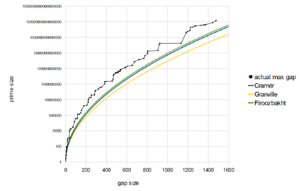Prime gap facts for kids

A prime gap is the space or difference between two prime numbers that come right after each other. Think of it like skipping numbers on a number line. If you have a prime number, the next prime number might be very close, or it might be quite far away. The n-th prime gap, often called gn, is simply the result of subtracting the n-th prime number from the next one (the (n + 1)-st prime).
For example:
- The first prime number is 2. The next is 3. The gap is 3 - 2 = 1. So, g1 = 1.
- The next prime after 3 is 5. The gap is 5 - 3 = 2. So, g2 = 2.
- The next prime after 5 is 7. The gap is 7 - 5 = 2. So, g3 = 2.
- The next prime after 7 is 11. The gap is 11 - 7 = 4. So, g4 = 4.
Mathematicians have studied these prime gaps a lot. However, there are still many puzzles and ideas (called conjectures) about them that haven't been solved yet.
Here are the first few prime gaps: 1, 2, 2, 4, 2, 4, 2, 4, 6, 2, 6, 4, 2, 4, 6, 6, 2, 6, 4, 2, 6, 4, 6, 8, 4, 2, 4, 2, 4, 14, 4, 6, 2, 10, 2, 6, 6, 4, 6, 6, 2, 10, 2, 4, 2, 12, 12, 4, 2, 4, 6, 2, 10, 6, 6, 6, 2, 6, 4, 2, ...
Contents
Cool Facts About Prime Gaps
The very first prime gap is 1, which is between the primes 2 and 3. This is the only gap that is an odd number. All other prime gaps are even numbers. This is because, except for 2, all prime numbers are odd. If you subtract an odd number from another odd number, you always get an even number.
There's only one time when two gaps in a row are both 2. This happens with the primes 3, 5, and 7. The gap between 3 and 5 is 2, and the gap between 5 and 7 is also 2.
Finding Really Big Gaps
Did you know that you can find prime gaps that are as big as you want? It's true! For any number you pick, there's a prime gap that's even bigger than that number.
Here's a simple idea to show this: Imagine you pick a number, say 5. The factorial of 5 (written as 5!) means 5 × 4 × 3 × 2 × 1 = 120. Now look at the numbers right after 120:
- 120 + 2 = 122 (divisible by 2)
- 120 + 3 = 123 (divisible by 3)
- 120 + 4 = 124 (divisible by 4)
- 120 + 5 = 125 (divisible by 5)
All these numbers (122, 123, 124, 125) are composite numbers (not prime). This means there's a gap of at least 4 numbers that are not prime. This sequence of non-prime numbers must be part of a prime gap. This idea works for any number, so you can always find a gap as large as you want.
However, these really big gaps don't always appear where you might expect them. For example, the first prime gap larger than 14 is between 523 and 541. That's a gap of 18. But 15! is a huge number (1,307,674,368,000)!
Average Gap Size
As prime numbers get larger, the average space between them also tends to get larger. It grows roughly with the natural logarithm of the prime number. This means that even though the gaps get bigger, they get smaller in proportion to the size of the primes themselves.
Twin Primes
A special idea called the twin prime conjecture suggests that there are infinitely many prime gaps of size 2. These are called twin primes, like (3, 5), (5, 7), (11, 13), and so on. It's one of the biggest unsolved mysteries in math!
Measuring Prime Gaps
Mathematicians use something called "merit" to compare how big a prime gap is compared to the average gap size around that prime. A higher merit means the gap is unusually large for primes of that size.
The largest known prime gap found so far (as of March 2024) has a length of 16,045,848! It's between two very large numbers, each with 385,713 digits. Imagine writing those numbers down!
The largest "merit" value ever found (as of September 2022) is 41.93878373. This was found by a computer network called Gapcoin. The prime number involved has 87 digits, and the gap to the next prime is 8350.
Record-Breaking Gaps
Here's a table showing some of the largest "merit" values found:
| Merit | gn (Gap Size) | Digits in pn | pn (First Prime) | Date | Discoverer |
|---|---|---|---|---|---|
| 41.938784 | 8350 | 87 | see above | 2017 | Gapcoin |
| 39.620154 | 15900 | 175 | 3483347771 × 409#/30 − 7016 | 2017 | Dana Jacobsen |
| 38.066960 | 18306 | 209 | 650094367 × 491#/2310 − 8936 | 2017 | Dana Jacobsen |
| 38.047893 | 35308 | 404 | 100054841 × 953#/210 − 9670 | 2020 | Seth Troisi |
| 37.824126 | 8382 | 97 | 512950801 × 229#/5610 − 4138 | 2018 | Dana Jacobsen |
Maximal Gaps
A "maximal gap" is a prime gap that is larger than all the prime gaps before it. It's like finding a new record for the longest jump. As of May 2024, the largest known maximal prime gap has a length of 1572. It was found by Craig Loizides and occurs after a very large prime number: 18,571,673,432,051,830,099.
Here is a list of the 82 known maximal prime gaps:
|
|
|
Big Ideas and Unsolved Puzzles
Mathematicians are always trying to figure out more about prime gaps. They use complex math to set "bounds" on how big or small these gaps can be.
How Big Can Gaps Be?
- Bertrand's postulate (proven in 1852) says there's always a prime number between any number k and its double, 2k. This means a prime gap can never be as big as the prime number itself.
- The prime number theorem suggests that as primes get bigger, the average gap between them grows slowly.
- More recently, in 2013, a mathematician named Yitang Zhang made a huge breakthrough. He proved that there are infinitely many prime gaps that are smaller than 70 million. This means that even very far out on the number line, you'll keep finding primes that are relatively close together. Other mathematicians then worked together to lower this number even further, down to 246! This is a big step towards solving the twin prime conjecture.
How Small Can Gaps Be?
- In 1931, Erik Westzynthius showed that prime gaps can grow faster than the logarithm of the prime numbers. This means that even though the average gap increases, there will always be some gaps that are much, much larger than average.
- Mathematicians have also proven that there are infinitely many prime gaps that are very large, growing in a specific way.
Conjectures: What Mathematicians Believe (But Can't Prove Yet)
Many ideas about prime gaps are still just conjectures. These are statements that mathematicians strongly believe are true, but they haven't found a complete proof for them yet.
- Cramér's Conjecture: This idea suggests that prime gaps are usually quite small. It says that the gap gn is roughly proportional to the square of the natural logarithm of the prime number.
- Firoozbakht's Conjecture: This is another idea that suggests prime gaps get smaller relative to the primes as the numbers get larger. If this is true, it would mean Cramér's conjecture is also true in a strong way.
- Oppermann's Conjecture: This is a slightly less strict idea than Cramér's. It suggests that prime gaps are usually smaller than the square root of the prime number.
- Andrica's Conjecture: This is even weaker than Oppermann's. It says that the gap gn is always less than twice the square root of the prime number plus one. This is related to the idea that there's always a prime between any two consecutive square numbers.
- Polignac's Conjecture: This is a very interesting idea. It says that every even number k appears as a prime gap infinitely often. For example, it suggests there are infinitely many gaps of size 2 (the twin prime conjecture), infinitely many gaps of size 4, infinitely many gaps of size 6, and so on. While not proven for any specific k, the recent breakthroughs by Yitang Zhang and others show that it's true for at least one even number less than or equal to 246!
See also
- Bonse's inequality
- Gaussian moat
- Twin prime


